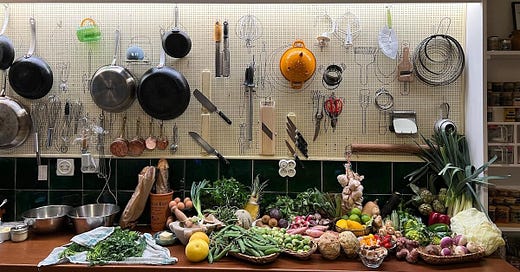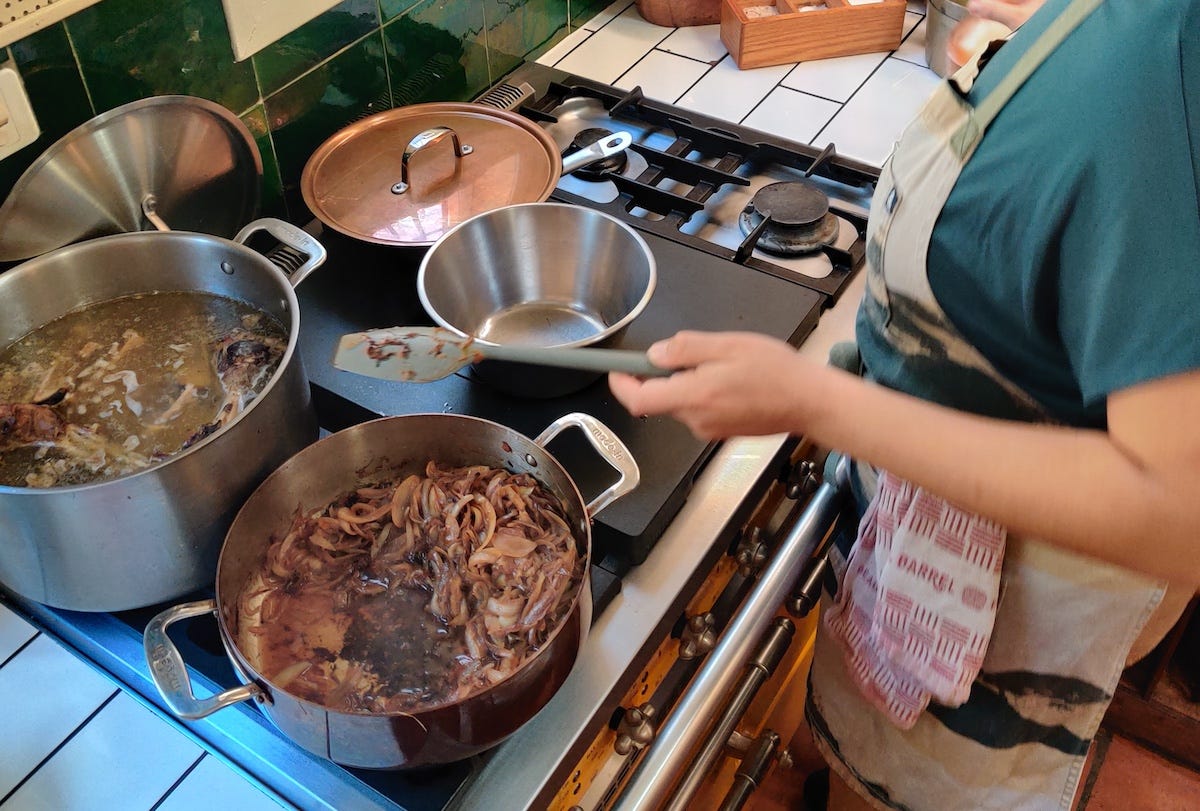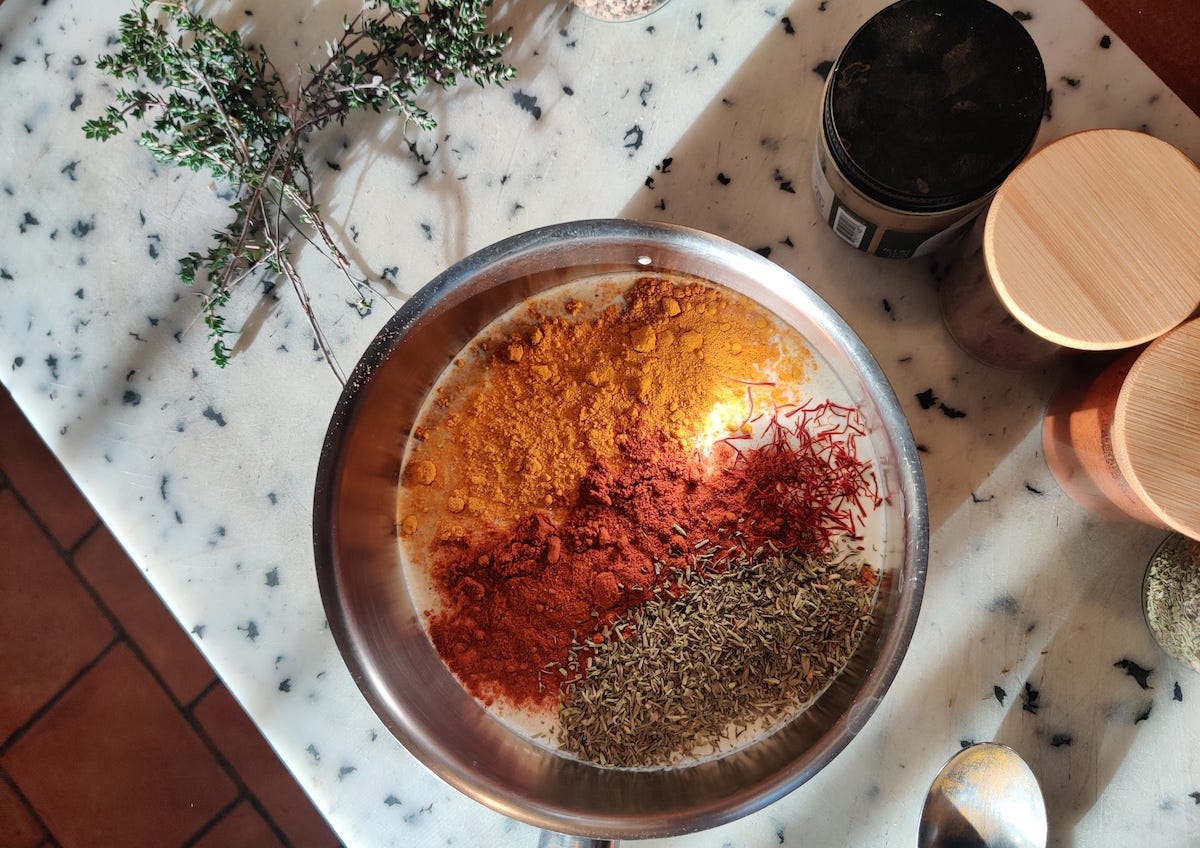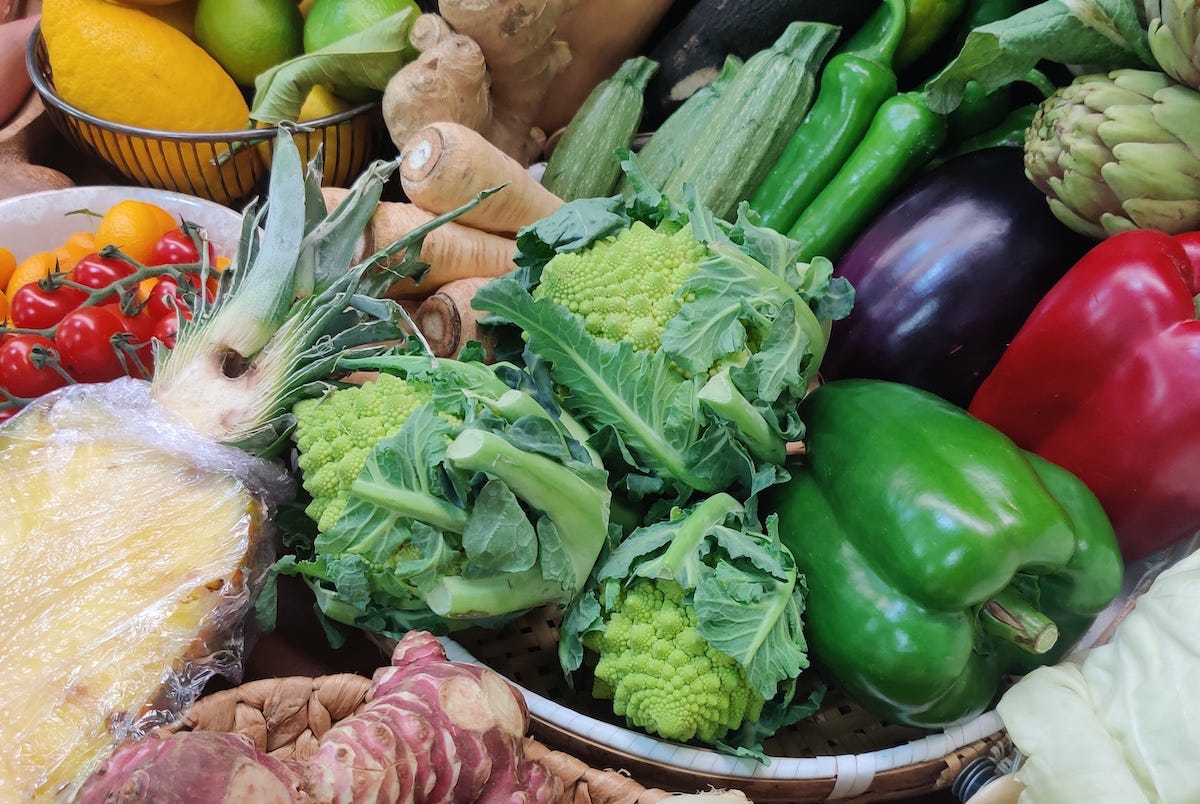I Went to Cooking School and Thought 'Julienne' Was Another Student
How the Courageous Cooking School changed my life
I’m standing over a skillet of browning onions in Julia Child’s kitchen in La Pichoune, the house in Provence she once shared with her husband Paul, trying to manage my anxiety. The onions are sizzling, but I’ve been instructed by Chef Kendall Lane not to stir. Everyone in class is staring at me staring at the fragrant onions, which I’m sure I’ve allowed to burn.
“Our instinct is to drop food in a hot pan and start stirring like mad. Why shouldn’t we do this?” asks Lane.
I know there’s a better answer than “because you said not to.”
“Because the onion needs to stay in contact with the heat. What are you doing when you stir them?”
“Keeping the onion from burning?”
“Keeping the onion from contact with the heat!” she says. “Keeping the onion from cooking!”
I am here at “La Peetch” for an intensive week-long cooking class at the Courageous Cooking School. I am here because I’ve never really learned how to cook. Oh sure, give me a recipe and I can follow it to the letter, but don’t expect me to know why I’m searing or sautéing or doing something fast or doing something slow. What does it even mean to “fold” in an egg?
Like many writers, I tried to solve my problem by writing about it. My suburban Southern California mom had been deeply inspired by Julia Child’s Mastering the Art of French Cooking and “The French Chef,” Julia’s groundbreaking 1963 cooking show. Hoping to infuse myself with my mother’s passion, I wrote Julia Child Rules: Lessons on Savoring Life. During a research trip to France in 2012, I even visited La Peetch. I visited this very kitchen and admired Julia’s iconic pegboard, on which all her cooking tools are hung. I tried to absorb some of Julia’s culinary mojo, to no avail.
La Peetch was built in 1965 with the royalties from Julia’s game-changing tome. Paul and Julia never actually owned the land; La Peetch sits on a corner of Bramafam, the domaine belonging to the family of Simone Beck, Julia’s collaborator. The handshake deal stipulated that Julia and Paul would “own” the house until they were ready to surrender it. In the early years Julia and Paul spent half the year in Provence, but in 1992, when Paul’s health was in serious decline, Julia visited La Peetch for the last time.
Entrepreneur and chef Makenna Held purchased La Pichoune, sight unseen, in 2015, after coming upon an ad in The New York Times announcing that Child’s Provençal home was for sale. Held, not afraid to leap before she looked, decided, pourquoi pas? La Peetch has become the centerpiece of Held’s hospitality group, which includes the cooking school, the live-streamed cooking platform RecipeKick, and Detour, a restaurant located in nearby Grasse, slated to open in 2026. Held’s first cookbook, Mostly French, will be published in April.
We begin each day at 9:00 am, in our matching tequila sunrise-colored aprons. The size of the class is small, the better to allow for a lot of individual attention. We are a mix of people who love to eat and love to cook, smitten with the legend of Julia Child. Tara is an organizational consultant from Paris. Alia is a memoirist from Portugal. Madalaine was a semi-finalist on Master Chef, and has published a cookbook. She’s here with her besotted husband, Jerry, who claims not to be a cook but, infuriatingly, seems to possess a natural flair for folding an omelet and flipping a crêpe.
On the docket for the first day: knife skills, omelets, frittatas, working with herbs and spices, and a crash course on the Courageous Cooking method. During the pandemic, when the cooking school was closed, Held created her own methodology for recipe-free cooking that trains home cooks how to build a dish the way a chef does. Her goal is to teach people to trust their instincts, have fun, and be fearless. By the end of the day, my notebook is already half full of scribbled notes.
Instruction chores are shared by Held and Chef Kendall Lane. Originally from Florida, Lane’s been working in kitchens since she was fourteen. She’s cooked in multiple Michelin star restaurants, and for time ran a nose-to-tail butcher shop in Chicago. Post-pandemic, she partnered up with Held to re-open the Courageous Cooking School, based on Held’s new technique.
Lane has an excellent cutting board-side manner. She doesn’t want her students to worry. She reassures us that no matter what you do, a soufflé will always fall. She says that when it comes to chocolate mousse, egg whites make it lighter, egg yolks and chocolate make it heavier. But either way, it’s all good. When chopping an onion, she says to go ahead and toss out the end. There’s no use risking cutting off the ends of your fingers. You can use it later for stock. Don’t be a hero. She teaches us how to make a hollandaise sauce that won’t break, how to properly butcher a chicken, and how to stand the classic French mirepoix on its head: we made one with leeks, parsnips, and mild jalapeño peppers.
We make a crazy-sounding custard using only ratios and a boatload of what seem to be incompatible spices: silk chili, cardamom, blue turmeric, and wild mesquite. The milk/cream mixture is infused for half an hour, and the resulting dessert is creamy, sweet, and slightly savory, unlike anything we’ve ever tasted.
One morning we go to Marché Forville in nearby Cannes, and are given 40€ to buy whatever moves us. “Don’t overthink it!” says Held, as she passes out our allowance. She advises us to follow our impulses. She tells us also to choose something that we prepare on auto-pilot. Into the straw panier go green beans, spinach, fennel, and a big black radish that looks fairly terrifying.
This, too, is a training exercise. The average recipe-follower (me) flips open a cookbook, decides to make something, then shops for the ingredients. It’s not done that way in France, or in the kitchen of the Courageous Cooking School. Here, the ingredients drive the dish: What’s in season? What looks bright and fresh? What makes you oooh and ahhh at nature’s bounty?
Among the group, haricots verts are a popular go-to veg. (I toss them in olive oil, roast, and finish with fleur de sel and a sprinkling of red pepper flakes.) Chef Kendall suggests we use them to make a green bean risotto with green olives, topped with a gremolata. I have no idea what that is, but I’m all for it. We make a mirepoix of leeks, parsnips, and sweet green peppers. We sauté it in duck fat infused with fennel and caraway. Before adding the parsnips, we coat them in olive oil and paprika, another way of adding flavor to the dish. A traditional gremolata is a sort of salsa made with parsley, lemon zest, and garlic. Ours also includes diced almonds and Macadamia nuts toasted in the same infused duck fat used for the mirepoix. We top our dish with grape tomatoes, and serve with a relish made of tender spring radishes and kumquats.
It’s the best thing I’ve ever tasted. I can’t get enough of it.
We retire to our respective guest rooms early, knackered after our hours of intense instruction. I’m staying in the red room, at one time Julia’s office. Held has an eye for the details that make guests feel cared for. There’s a cashmere Hermès throw at the foot of each bed, and the kitchen is open 24/7 for snacks.
I snuggle beneath the cozy throw. I try to summon the spirit of Julia, but she’s not there. I think about how what goes around comes around. Julia Child’s simple mission was to make French cooking—at the time universally acknowledged as the best cuisine in the world—accessible to the American home cook. This meant translating classic French dishes, passed down from generation to generation and rarely written down, into recipes anyone could follow. It meant writing instructions that could be frankly daunting. In some cases, it meant making cooking harder than it needed to be. Held and Lane, similarly enterprising modern American women, are in some ways helping home cooks return to the original French ways of doing things. Just last week in our village of Collioure, some neighbors got together to make cassoulet. They all had their own methods, and they argued about the best way to make it, but no one gave a single thought to consulting a recipe.
This essay originally appear in Frenchly.








What a wonderful write up. Thanks for sharing this.
This sounds like a perfect way to continue with Julia’s heritage.